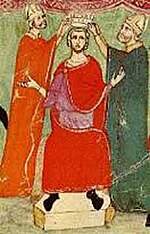
Back Nuova Cronica Catalan Nuova Cronica Esperanto Nova Cronica French A három Villani krónikája Hungarian Nuova Cronica ID Nova Cronica Italian Nuova Cronica Polish Nuova Cronica Portuguese

The Nuova Cronica (also: Nova Cronica) or New Chronicles is a 14th-century history of Florence created in a year-by-year linear format and written by the Italian banker and official Giovanni Villani (c. 1276 or 1280–1348). The idea came to him in the year 1300, after attending Rome's first Jubilee (special year of remission of sins, debts and universal pardon). Villani realized that Rome's many historical achievements were well-known and desired to lay out a history of the origins of his own city of Florence.[2] In his Cronica, Villani described in detail the many building projects of the city, statistical information on population, ordinances, commerce and trade, education, and religious facilities. He also described several disasters such as famines, floods, fires, and the pandemic of the Black Death in 1348, which would take his own life.[3][4] Villani's work on the Nuova Cronica was continued by his brother Matteo (from April 1348 until July 1363) and his nephew Filippo (until 1364) after his death.[2][5][6] It has been described as the first introduction of statistics as a positive element in history.[7]
The oldest manuscript is Vatican Library BAV Chigiano L VIII 296, dating to the time of composition.
- ^ Rudolph, 66.
- ^ a b Bartlett, 36.
- ^ Bartlett, 36, 38.
- ^ Benedictow, 69.
- ^ Cite error: The named reference
caesar 148was invoked but never defined (see the help page). - ^ Kleinhenz, 1144.
- ^ Villani, Giovanni. Encyclopædia Britannica. Encyclopædia Britannica 2006 Ultimate Reference Suite DVD. Retrieved on 2008-03-04.